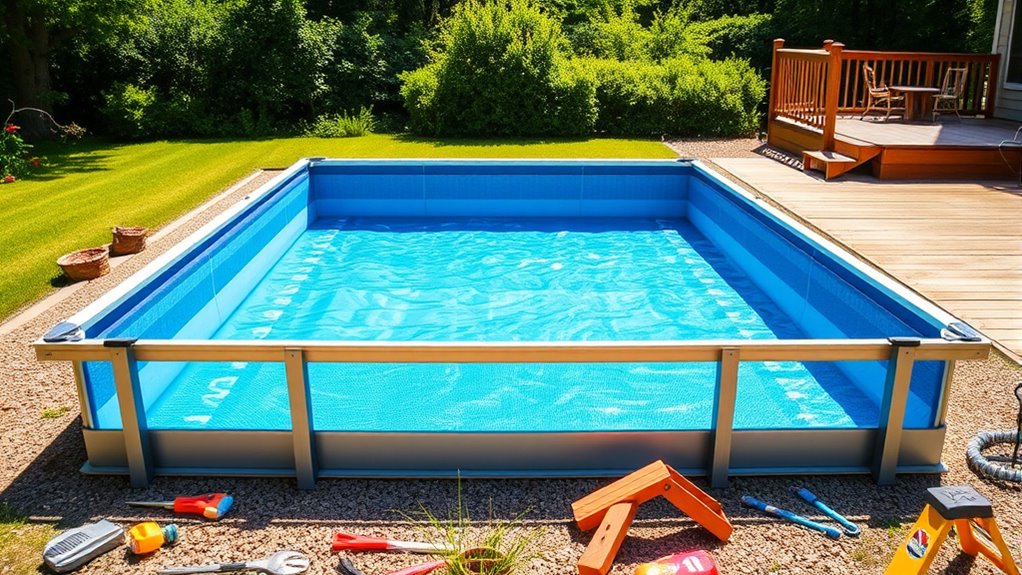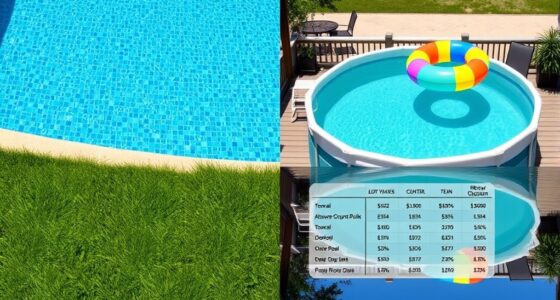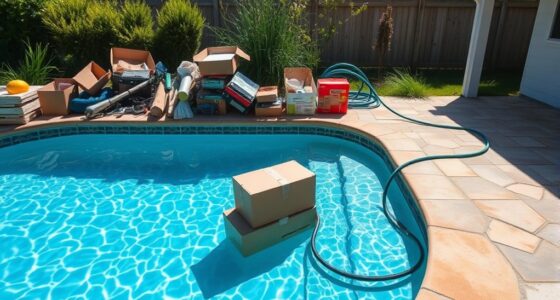DIY pool kits can save you money upfront, but they require careful planning, skills, and time to guarantee everything’s installed correctly. Mistakes in excavation, assembly, or connections can lead to leaks, structural issues, or higher long-term costs. If you’re willing to learn new skills and put in the effort, it might be worth it. Keep exploring to discover the key factors that can make or break your DIY pool project.
Key Takeaways
- DIY pool kits are cost-effective upfront but may incur hidden expenses from installation errors or site preparation issues.
- Proper excavation and assembly are vital; mistakes can lead to leaks, instability, or costly repairs later.
- Installing a pool yourself requires skills in plumbing, electrical work, and site leveling, which can be challenging for beginners.
- The installation process can take several days or weeks, demanding significant time and effort from the owner.
- Correct initial setup ensures long-term durability and safety, making professional help potentially more economical over time.

Thinking about installing a pool yourself? Taking on a DIY project with a pool kit can seem like a smart way to save money and enjoy the satisfaction of building your own backyard oasis. However, before diving in, it’s essential to consider the installation challenges you might face and the true cost considerations involved. While DIY pool kits are designed to be more accessible than hiring professionals, they still require a fair amount of planning, effort, and skill. One of the main installation challenges is ensuring proper excavation and leveling of the site. If the ground isn’t perfectly prepared, your pool could end up uneven or prone to shifting, which might cause leaks or structural issues down the line. It’s not just about digging a hole; it’s about doing it precisely and safely. Additionally, assembling the kit components correctly is vital. Many kits come with detailed instructions, but if you’re not comfortable with DIY tasks or lack experience with plumbing and electrical connections, you might encounter difficulties that delay installation or lead to costly mistakes.
Cost considerations are another essential factor. While DIY kits typically cost less upfront than professional installation, you often need to factor in additional expenses. These can include purchasing or renting excavation equipment, buying extra materials like concrete or reinforcement, and possibly hiring specialists for specific tasks you’re not equipped to handle. Sometimes, unforeseen issues—such as poor soil conditions or hidden underground utilities—can increase costs notably. Moreover, if the pool isn’t installed correctly, you might face expensive repairs or even have to redo parts of the project. It’s tempting to think you’re saving money by doing it yourself, but sometimes the hidden costs and potential for mistakes make professional installation more economical in the long run.
Another aspect to consider is the time commitment. DIY pool installation isn’t a quick weekend project; it can take several days or even weeks, especially if you run into problems or need to learn new skills along the way. This can be frustrating, particularly if you’re enthusiastic about enjoying your pool during a specific season. Also, consider the ongoing maintenance knowledge you’ll need to keep your pool in good shape. While a DIY kit puts you in control, it also puts responsibility on your shoulders for proper operation and long-term upkeep. Proper planning and understanding of installation procedures can significantly impact the success of your project.
Frequently Asked Questions
What Are the Hidden Costs of DIY Pool Kits?
When considering DIY pool kits, you might overlook hidden expenses and ongoing maintenance costs. These hidden expenses can include unexpected repairs, extra equipment, or professional help if things go wrong. Maintenance costs also add up over time, with chemicals, cleaning, and equipment replacements. You need to plan for these costs upfront to avoid surprises, ensuring your DIY pool remains enjoyable without draining your budget unexpectedly.
How Long Does It Typically Take to Install a DIY Pool?
Think of installing your DIY pool like building a ship in a bottle—meticulous but doable. The installation timeline varies, typically taking 2 to 4 days, depending on your experience and project complexity. Labor requirements are manageable if you’re handy, but don’t underestimate the effort. You’ll need time for site prep, assembly, and filling. Planning ahead guarantees you won’t be caught in choppy waters when it’s time to enjoy your new pool.
Are DIY Pool Kits Suitable for Uneven or Sloped Yards?
If your yard has slope challenges or isn’t level, DIY pool kits might not be the best fit. These kits typically require yard leveling to guarantee proper installation and stability. Attempting to install on uneven ground can lead to structural issues or leaks. For sloped yards, consider professional help or custom solutions that accommodate the terrain, ensuring your pool remains safe and durable.
What Safety Precautions Should I Consider During Installation?
During installation, you should prioritize pool chemical safety by storing chemicals properly and following instructions carefully. Guarantee electrical grounding to prevent shocks and short circuits, especially around water. Always wear protective gear, work in a well-ventilated area, and keep children or pets away. Double-check all connections, and if you’re unsure, consult a professional. Taking these precautions helps keep your installation safe and hassle-free.
Can I Customize a DIY Pool Kit Easily?
You can customize a DIY pool kit quite easily by focusing on your pool design and material selection. Many kits offer flexible options to match your preferred shape, size, and features. You’ll find that choosing different materials, like liner types or wall finishes, allows you to personalize your pool. Just guarantee you follow the manufacturer’s guidelines and consider your skill level to make customization smooth and achievable.
Conclusion
Deciding on a DIY pool kit demands diligence and dedication. While it might seem simple, the potential pitfalls can pile up if you’re not prepared. Weigh the worth of work versus worry, and whether you’re willing to weather the worries and work. Remember, proper planning and patience pave the path to a perfect plunge. Ultimately, if you’re ready to wrestle with the workload, a DIY kit could be a rewarding, worthwhile project—just be willing to work!









